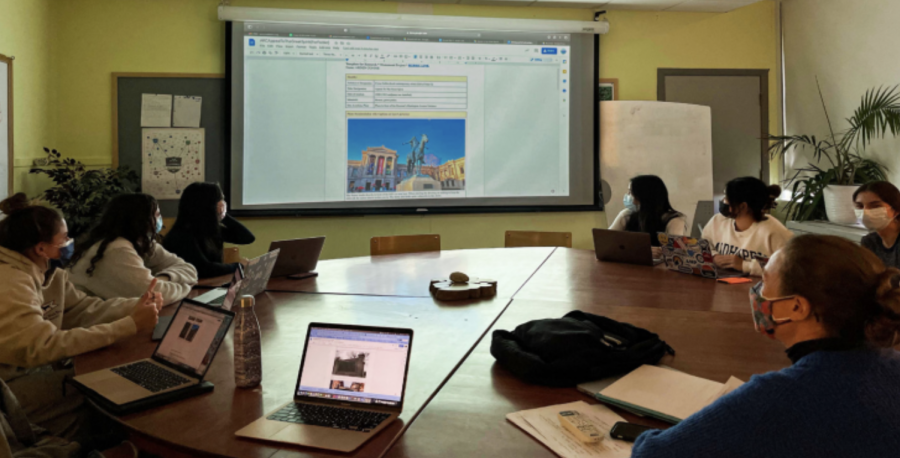Creativity meets history in new art history curriculum
Seniors examine and reimagine monuments
February 9, 2022
This year, Advanced Placement (AP) and Honors Art History students are bringing history to the present through Upper School (US) Art Teacher Nicole Stone’s new addition to the curriculum: examining and reimagining monuments.
“We are all surrounded by monuments, but we don’t really think about them as art,” Ms. Stone said, “yet, in reality, they have existed to reinforce society throughout time.”
Last spring, Ms. Stone applied for and won an innovation grant provided by the new I-Team, in which she detailed a course focused on monuments and their role in the history of art. The idea originated from discussions with last year’s AP Art History students, Ms. Stone said, who were interested in looking at the social impacts of art.
Lately, there has been a growing awareness of the significance of public art, Ms. Stone said, which partially inspired the adapted curriculum. George Floyd’s death and the reckoning with systemic racism that followed, she said, created rising activism around memorials and their role in society.
“Recent history has led to a lot of reconsideration of the role of monuments,” she said. “Monuments have been taken down,
recontextualized, and discussed in public ways. Taking down monuments has happened as a way of protest and a way of trying to reconsider the stories we as a society tell about who we are and what we care about. I’d say that 10 years ago, at least in the U.S., there wasn’t as much acknowledgement on the power of public art.”
These monuments have left behind a legacy for people throughout history to interpret, Ms. Stone said, and she hopes her students can discover this through this project.
“I hope they learn that art has power, and that they as students of art history also have power,” she said.
Students began the project-based curriculum this winter with initial research on a local monument through a contemporary lens. The monuments include “The Sphinx” at the Mount Auburn Cemetery, Longfellow House-Washington’s Headquarters, the Emancipation Memorial, the Boston Founders Memorial, and “Appeal to the Great Spirit” at the Museum of Fine Arts. The students considered the ways these monuments were perceived throughout history and how their roles may have changed over time.
Elaine Mo ’22, who researched the Founders Memorial, said the memorial focuses on the founding of Boston and hides the theft of land from Native Americans.
“So far, I’ve learned that many monuments in the U.S. show the same celebrated stories while undervaluing or concealing many other voices,” Elaine said. “Monuments are extremely important in how people see history, especially since they’re out there for the public to see; they show us the values of a society. Many monuments support a conventional, preferred understanding of a historical event and not all of it,” Elaine said.
Additionally, guest speakers educated students on the interpretation of various monuments throughout the project. Emily Levine, a ranger working at Longfellow House-Washington’s Headquarters, spoke about the stories of enslaved people at the house on January 21. On January 28, Camilo Alvarez spoke about his experience on the Boston Art Commission when it removed the Emancipation Group statue from public space.
The students began part two of the project in February, in which they create a proposal and outline for a sculpture or plaque to counteract the erasure of history, before presenting their monument on February 11.
Sofia Chen ’22 said she was excited to connect her creativity with history.
“I’m really excited for what the outcome will be and the creativity the second part of the project will bring. It’ll be an opportunity for me to connect my love of art with the information I’ve learned to create something,” Sofia said. “Sharing in class will also be very exciting because we’ll be getting overall context from the piece that we might have not known but also hear views that we might not have known.”
Talia Beckhardt ’22 said the monument project provided a different perspective from the standard Art History curriculum. “None of the stuff we’ve studied before has been monuments, so I’m really just interested in learning what sorts of decisions go into their creation and how people interpret them and decide if they should still exist or should be changed,” Talia said. “It’s nice that the school is experimenting with new things in terms of what projects happen in the class.”
After the project ends, Ms. Stone plans to study its impacts on her students and her teaching methods through the school’s Action Research Project and then modify the curriculum based on student feedback.

